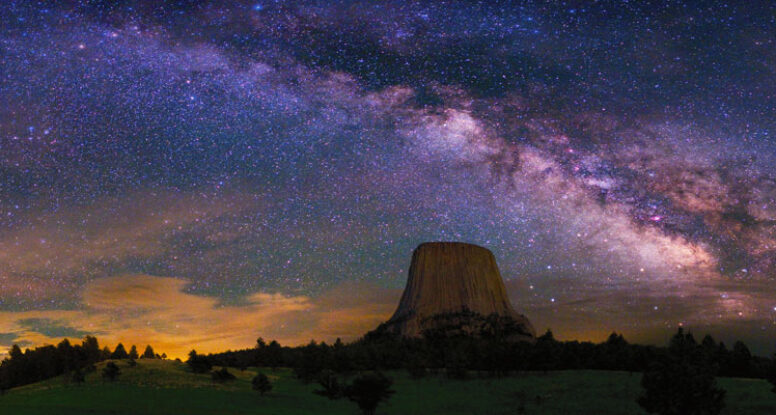
How Old is Earth?
The Earth solidified 4.54 billion years ago, plus or minus 1%. That’s a fact, and if your belief is not aligned to this fact, then you are what we call “wrong.”
This age is arrived at by several cross-checking lines of evidence, but the great antiquity of the Earth has been apparent for much of human history. True, scientific progress repeatedly found our home to be much older than previously suspected, but the widespread view that the planet is only a few thousand years old is relatively new, and has no basis in either fact or scripture.
The 6,000 year age was arrived at by James Ussher, a 17th century Irish Archbishop who counted up estimates of the ages of Abraham’s family listed in the old testament and calculated that the creation began (on the Julian calendar) on Saturday, October 22, 4004 BC, at 6 pm.
Yeah. Really.
Ussher made a lot of assumptions, chose to ignore inconsistencies within even those scriptural sources known at that time, and was unaware of certain now obvious translation issues, importantly including the way the Babylonians counted, but that’s beside the point. As William Henry Green wrote, “the Scriptures furnish no data for a chronological computation prior to the life of Abraham; and the Mosaic records do not fix and were not intended to fix the precise date either of the Flood or of the creation of the world.”
In other words, even if Ussher’s calculation were correct (it isn’t) it would only tell us when Abraham lived, not when the world was made.
But even this doesn’t matter, for as Thomas Paine reminded us, the only revelation we can really trust is the creation itself. When nature disagrees with scripture, scripture (which is given to us by man) must necessarily be wrong.
Nature tells us Ussher was off by six orders of magnitude.
- The Earth formed a persistent solid surface 4.54 billion years ago.
- Life appeared no less than 3.8 billion years ago.
- A billion years later, cyanobacteria started producing oxygen as a waste product, and this started precipitating iron dissolved in the oceans into the deposits we now quarry for ore.
- Half a billion years later, oxygen started to accumulate in the atmosphere, and in another half billion, rose high enough to trigger an ecological collapse and rebalancing in which plants and animals came to dominate the biosphere.
- By half a billion years ago, complex life had spread through the ocean and diversified into all the basic body plans that still exist today (and a lot that don’t).
- Simple swimmers gave rise to armored swimmers, then bony fish, tetrapods, amphibians, reptiles, and dinosaurs—all built on the same basic body shape.
- Almost all the Earth’s known petroleum was formed less than 160 million years ago. Oil formed before that (from bacteria and plankton) but few older deposits have been protected from geologic processes that destroy hydrocarbons. Half of all known reserves are less than 65 million years old.
- By this time, mammals had appeared and some had returned to the sea and were well on their way to evolving into whales.
- Our lineage split off from the other apes about 5.5 million years ago. We’ve gone through roughly twenty species since then (though the concept of species is our own invention).
- Neanderthals appeared in Europe about a quarter million years ago. If they were alive today, they could probably run for congress (that’s not intended as an insult). They might even do better than those now in Congress (that is).
- Various groups of humans started domesticating crops and animals between 16,000 and 8,000 years ago, which is why most young Earth wackadoes now argue for an Earth around 10,000 years old instead of Ussher’s increasingly ridiculous 6,000.
But here’s the thing. The dendrochronologic record—last I checked—now goes back 12,000 years in some parts of the world. You don’t trust radiometric dating? Fine. Buy a magnifying class and a box of Twinkies and visit a dendro lab. Tree rings form a unique fingerprint as trees across a region are exposed to similar conditions. For this reason, overlapping ring patterns from living, dead, and fossilized trees can be lined up to build continuous series stretching back through thousands and thousands of years. 12,000 and counting. No fancy science required.
And at a certain point, the dendro dates line up with ocean core dates and pack ice dates, both of which go back hundreds of thousands of years—but that might take a little scientific know how. Easier are simple geologic strata:
This is the Grand Canyon:
Those lines are sedimentation lines that form 40 major layers spanning 2 billion years of deposition. Okay, you might need a degree in geology to tell desert sand deposition from silt and to follow the series around the American West to account for disconformities, but even a casual, unbiased evaluation will convince you utterly of two things: 1) The canyon was laid down by erosion through ancient sediments, not cut by any flood, and 2) those sediments were laid down over many, many, many millions of years.
And that’s just scratching the surface, so to speak. Even the Pope knows the Earth is 4.54 billion years old. When you accept it and start studying the data, you’ll discover something important. Many of those loudly proclaiming a young Earth these days must unavoidably understand how far their claims are from what the Earth really tells us—but they keep on saying it anyway, and selling books and lecture tickets. I wonder why they would do that? Life tip: It isn’t to serve God, or the truth, or anything noble.
If you like science and deep time, you might enjoy my free award-winning scifi sampler.
